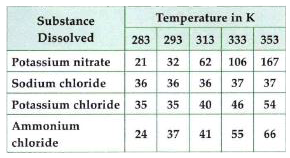Sudha tested the solubility of four salts X, Y, Z and T as different temperature and collected the following data. (Solubility refers to the amount in grams dissolved in 100 g of water to give a saturated solution.)

Answer the following question from the table
(i) Which salt has the highest and lowest solubility at 323 K ?
(ii) A student prepared a saturated solution of X at 323 K and then added 25 g water to it. Water mass of X must be added to again make the solution saturated ?
(iii) The solubility of which salt is least affected by increase in temperature ?
(iv) What mass of 'T' would be required to make saturated solution in 200 g of water at 290 K ?
(I) At 323 K, salt Y has the highest solubility in water while salt Z has the lowest solubility
(ii) By definition of saturated solution,
100 g of water at 323 K contain salt = 40 g
125 g of water at 323 K contain salt = (40g)(100g)×(125g)=50g
∴ Mass of salt to be added to make the solution again saturated = (50 - 40) = 10 g
(iii) The data shows that the solubility of the salt Y is least affected with increase in temperature.
(iv) At 290 K, mass of T required to make the saturated in 200 g of water = (25g)(100g)×(200g)50g
Related Playlists
- BOOK - DINESH PUBLICATIONCHAPTER - IS MATTER AROUND US PUREEXERCISE - HOTS6videos
IS MATTER AROUND US PURE
- BOOK - DINESH PUBLICATIONCHAPTER - IS MATTER AROUND US PUREEXERCISE - MCQ9videos
IS MATTER AROUND US PURE
- BOOK - DINESH PUBLICATIONCHAPTER - IS MATTER AROUND US PUREEXERCISE - Short Answer Questions58videos
IS MATTER AROUND US PURE
- BOOK - DINESH PUBLICATIONCHAPTER - ATOMS AND MOLECULESEXERCISE - LONG ANSWER QUESTIONS24videos
ATOMS AND MOLECULES
- BOOK - DINESH PUBLICATIONCHAPTER - MATTER IN OUR SURROUNDINGS EXERCISE - (LAQs) Long Answer Questions5videos
MATTER IN OUR SURROUNDINGS
Similar Questions
the solubility of which of the following salts does NOT increase with temperature ?
View SolutionPragya tested the solubility of three different substances at different temperatures and collected the data as given below (results are given in the following table, as grams of substance dissolved in 100 grams of water to form a saturated solution).

Find the solubility of each salt at 293 K. Which salt has the highest solubility at this temperature?View SolutionWhich of the following has the lowest solubility in water?
View SolutionPragya tested the solubility of three different substances at different temperatures and collected the data as given below (results are given in the following table, as grams of substance dissolved in 100 grams of water to form a saturated solution).

What is the effect of change of temperature on the solubility of a salt?View SolutionThe solubility of common salt in water at 293K is 36g. The mass ( in g ) of common salt needed to make a saturated solution in 20g water at 293 K is ________________.
View SolutionWhich of the following has highest solubility in water ?
View SolutionWhich of the following gas has highest solubility in water?
View SolutionWhich of the following gas has highest solubility in water?
View SolutionPragya tested the solubility of three different substances at different temperatures and collected the data as given below (results are given in the following table, as grams of substance dissolved in 100 grams of water to form a saturated solution).

Pragya makes a saturated solution of potassium chloride in water at 353 K and leaves the solution to cool at room temperature. What would she observe as the solution cools? Explain.View SolutionPragya tested the solubility of three different substances at different temperatures and collected the data as given below (results are given in the following table, as grams of substance dissolved in 100 grams of water to form a saturated solution).

What mass of potassium nitrate would be needed to produce a saturated solution of potassium nitrate in 50 grams of water at 313 K?View Solution

